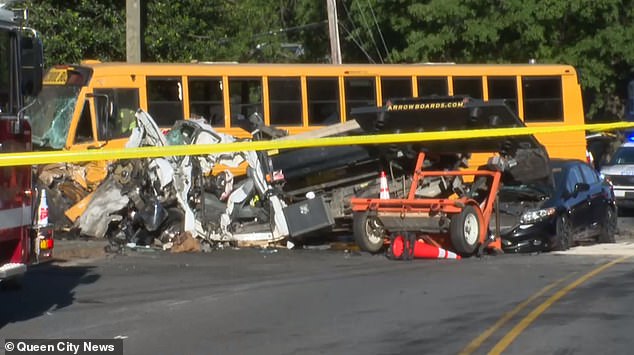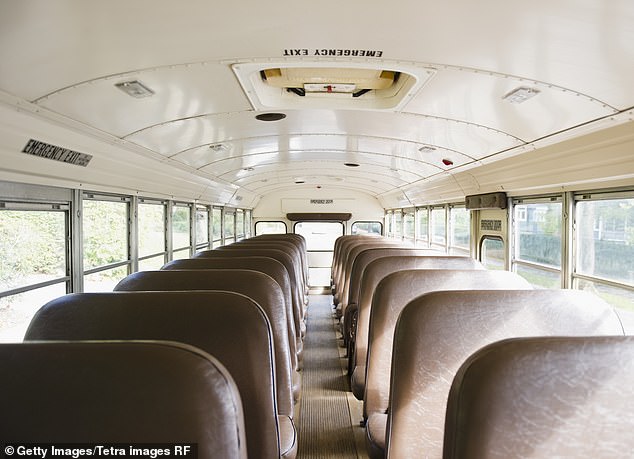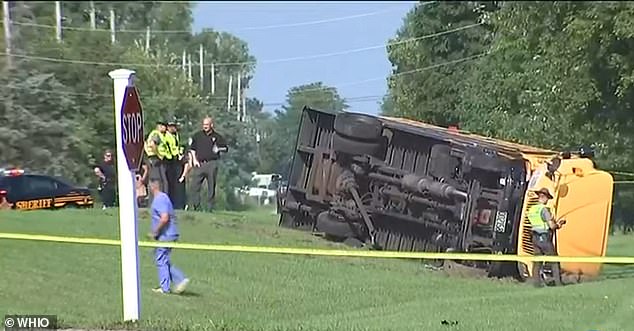America’s school bus shame: Ancient seatbelt-less ‘deathtraps’ are injuring a staggering 26,000 children every year amid shortage of trained drivers
For years, campaigners have warned that there is a secret killer on America’s roads, endangering millions of children and motorists: school buses.
This week, 11 children and two adults were rushed to the hospital when their school bus crashed into a Honda Accord in Bel Air, Maryland.
The shocking crash was preceded by another in Pennsylvania a week earlier, which left 49 children and two adults hospitalized after the school bus crashed into a tow truck.
According to the data tracking site, an average of 121 fatalities are recorded annually in school bus accidents, injuring as many as 26,000 children. Gitnux market data.
It has led campaigners to warn that the outdated shuttles without seatbelts are putting lives at risk. And while concerned parents may be shocked to learn these statistics, many have been wondering for a while: Why won’t America upgrade its school buses?
A slew of recent school bus accidents have raised questions about the safety of the vehicles, which transport more than 25 million children every day. Pictured: A school bus after a horror crash that hospitalized 49 children and two adults in Pennsylvania on September 6

Disturbing statistics show that the buses are dangerous, both because of the lack of seat belts and because of the risk the enormous vehicles pose to other drivers. Pictured: A massive multi-car pileup following a school bus crash in North Carolina in May 2022 that left 15 children hospitalized
Today, school buses are America’s largest public transportation system, with more than 25 million schoolchildren riding more than 480,000 school buses every day, according to The Guardian. American School Bus Council.
Of the 26,000 injuries related to school buses, 54 percent are due to car accidents directly involving the buses, with a large majority of deaths resulting from other motorists colliding with the cumbersome vehicles.
This trend has led to horror accidents in recent weeks in Ohio, Massachusetts and Maryland, among others, but one of the root causes of the problem may lie deeper: the lack of seat belts on school buses across the country.
The reason has some scratching their heads, as the National Highway Transportation Safety Administration stipulates that only buses with a gross vehicle weight of 10,000 pounds or less must be equipped with seat belts.
While this sounds high, most school buses weigh around 25,000 pounds, and officials have apparently opted for a system of “compartmentalization.”
Eight states have legislation mandating seat belts on school buses, while the other 42 have the option of leaving millions of schoolchildren “restrained” only by tightly packed and padded seats.
As evidence of the shortcomings of this approach, shocking footage from a horror school bus crash shows unprotected children being sent into the air as the heavy machinery topples over.
But while drivers – who wear seat belts – can be blamed for some accidents, it appears that the buses can be dangerous even when stationary, with more than 3,000 injured every year from children just climbing on and off the bus.

Campaigners have warned that the absence of seat belts in favor of tight, cushioned ‘compartments’ on school buses is a dangerous shortcoming
Despite sending countless children to the hospital, NHTSA has defended keeping the “solution” over shelling out some upgrades.
“There is no doubt that seat belts play an important role in keeping passengers safe in these vehicles,” the authority said. Motor cookie.
“But school buses are different in design, including a different type of security system that works extremely well.”
While the transit agency may claim they work “extremely well,” one person who disputes that claim is 75-year-old Rudy Breglia, a safety activist who founded the organization School Bus Seat Belt Safety Alliance in 2016 after a fatal crash in Chattanooga, Tennessee. It was one of the worst in recent history, with six students tragically killed.

Aiden Clark was tragically killed last month in an accident in Springfield, Ohio, which also injured 27 other students
Breglia says he has spent seven years pleading with officials to listen, admitting that the lack of action has increasingly concerned him.
“I feel like I have to get it done before that big crash happens,” he said NPR last month. Some may argue that this has been the case repeatedly.
Breglia spoke after elementary school student Aiden Clark, 11, was tragically killed last month when he was thrown from a bus when his school bus overturned in Springfield, Ohio.
Over twenty students were also injured in the same accident, none of whom had the option of wearing a seat belt, unlike the driver.
While it is true that a large number of school bus deaths involve the other vehicle in the collision, these numbers will provide little comfort to parents who send their children to school every morning.
Following the devastating crash that killed the 11-year-old, Ohio Governor Mike DeWine cited the tragedies in his state as a reason for launching a task force to investigate the issue.
“We can make it safer and that’s what we want to look at,” he said.
“Seat belts are certainly one of the things this task force will look at, but they will look at other things as well. They will look to see if we have missed anything over the years (such as the patrol inspection, the buses, the bus driver).’

The school bus from which Aiden Clark was thrown and 27 other students were injured had no seat belts and its significant weight caused the vehicle to roll over

Rudy Breglia, a campaigner for school bus safety, has been frustrated by a lack of action over the lack of seat belts on school buses for seven years, but says he is more determined than ever because he has to “get it done before there is a major accident” takes place’. ‘
Before DeWine brought the issue to a task force, there were signs that the fleet of school buses littering America’s streets was slowly undergoing environmentally friendly improvements.
In June 2023, the Department of Transportation announced it would award nearly $1.7 billion in grants to purchase low-emission buses in 46 states and territories.
The grants will be used to purchase about 1,700 ecobuses, a relatively small portion of the 480,000 school buses on U.S. roads.
The concerns come amid an ongoing shortage of school bus drivers that is causing chaos across the country, with children arriving late or arriving home after dark.
HopSkipDrive, which provides school transportation services, has released data showing that driver shortages are increasing, with 92 percent of school leaders reporting operational issues as a result.
The issue has prompted school districts in states such as Kentucky, Illinois and Florida to reconsider their transportation plans, leading to massive delays, canceled classes and stranded children.
